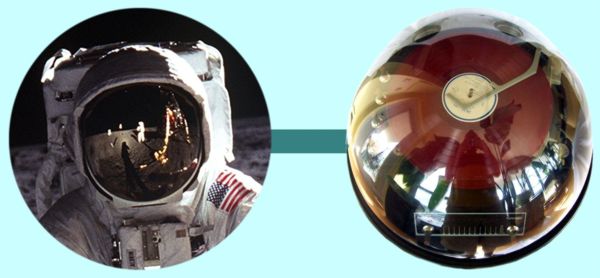|
Another Canadian Icon, the 1971 Electrohome Space Age Bubble Stereo "CIRCA 711" with Gold Anodized Tulip Pedestal and Original Eyeball Speakers, Serviced and Working
In a Nutshell
This universal stereo unit is an adornment for every home. It's not only an unshakable work horse, it will be a centerpiece for your and your guests eyes to gaze at. Even your kids can manage it - unattended - it's all automatic

Introduction:
Obviously inspired and impressed by the eminent 20th century event of the first successful manned mission to the moon on July 20th, 1969 the Canadian Consumer Electronics producer Electrohome in Kitchener, Ontario launched its "Apollo" series of stereo combos and record players in 1970, one year after the event. The series in 1972 was renamed "Saturn". Four versions, with/without an AM/FM receiver, and with/without a tulip shaped floor pedestal, were produced. The stereos came with two spherical black anodized metal eyeball speakers on various own stands. The turntable is made by renowned BSR (Birmingham Sound Reproducers) Limited of Great Britain, one of the most prolific and experienced turntable manufacturers. It plays 12" 10" or 7" records with 16, 33, 45 or 78 rpm. It works as an automatic record changer too. It has a flip-flop cartridge with separate needles for 33/45 and 78 rpm records. It has a headphone jack (on the operation panel) and 4 jacks for tape in and out (on the bottom). So, you can connect other audio equipment like a tuner, a tape deck, a CD player, mp3 player or iPod to the amplifier.
Additional information:
ref. 1. http://en.wikipedia.org/wiki/Electrohome
ref. 2. http://cgi.ebay.com/ws/eBayISAPI.dll?ViewItem&item=110438041002
For the historians only:
After the Mercury program had proven that manned spaceflight was possible, the Apollo program was launched to do space exploration around (but not on) the Moon. Speaking to Congress and the Nation, President John F. Kennedy on May 25, 1961 radically altered the direction of the Apollo program by saying: "I believe that this nation should commit itself to achieving the goal, before this decade is out, of landing a man on the Moon and returning him safely to Earth. No single space project in this period will be more impressive to mankind, or more important in the long-range exploration of space; and none will be so difficult or expensive to accomplish" (pict.21). The projected price tag was an incredible $25 billion dollars. The Apollo program included eleven manned flights, designated Apollo 7 through 17. On July 16-24, 1969 Apollo 11 (Columbia and Eagle) on a Saturn V with the astronauts Neil A. Armstrong (commander), Michael Collins (CM pilot), Edwin E. (Buzz) Aldrin Jr. (LM pilot) (pict.22) accomplished the first manned lunar landing and lunar surface exploration
(EVA). The event in the early 70's sparked a world-wide "space age" touch in music, arts, and basic commodity design.
Early success of Canadian Clairtone ("Project G") convinced Electrohome to adapt the Canadian government's new satellite communication strategy for the home market ("Hemisphere 80", CIRCA 75, never realized). Electrohome's design director Gordon Duern and junior designer Keith McQuarrie in 1966 designed Apollo 860 for Electrohome as part of a previously founded Circa Product Group. Its satellite eyeball speakers, and its smoked acrylic bubble lid exemplified futurism. According to the Design Canada report, the company wanted to create a dynamic image to appeal to the growing teenage market ("Now generation"). The stands are said to have been inspired by Finnish designer Eero Saarinen's [1910-1961] famous tulip tables and chairs of 1956.
About my stereo:
The unit is in mint condition, visually and technically. The highly reflective but semitransparent smoked acrylic bubble hood has no cracks, scratches or scuff marks. The structured plastic of the base has its original deep black with no marks, no dust corners, no dents on the metal parts. The knobs look like new. The speakers have retained their velvet black surface with no scratches or dents. The gold anodized aluminum stand has no dents or gazes.
The player works flawlessly in all operating modes, with no glitches and its sound quality is impeccable, loud and clear and without hum. The missing cartridge was replaced by a brand-new ceramic cartridge with flip-flop needles, that has a large gain. There is no indication that the motor is stressed when performing the extra load during record changing, as is often the case in older wrongly lubricated units. The two units on auction are the 3rd and 4th I have restored. 7 of the 8 speakers had to be reconed, a typical example being shown in pict.15). I may say, that all original speakers are shot, since the cone surrounds get dissolved and break away.
Summarizing this 1971 Electrohome CIRCA 711 radiogram serves all your vinyl and all your connectivity needs, and represents a lovely and decorative piece of 20th century space age design. I let the pictures speak for themselves, and wish I could do the same for the sound quality. Please e-mail me (Kris) for any questions, ich spreche Deutsch, je parle Français.
Here are the specifications:
Technical Description of Item |
| Manufacturer |
Dominion Electrohome, Kitchener, Ontario, Canada |
| Model |
CIRCA 711 Mod. No. 18-400203-69 |
| Type |
Transistorized AM/FM stereo radio |
| Turntable type |
4-speed all-size motor-driven BSR record changer with dual flip-flop needle |
| Production Year |
1971 |
| Serial Number |
2-206695 |
| Cabinet |
Gold anodized aluminum tulip stand, smoked acrylic dome hood, black plastic |
| Dial |
Green backlit lucite |
| Speakers |
4" PM speakers in black anodized metal spheres 8" dia. on "Yoyo" stands |
| Frequency Range |
AM / FM / FM Stereo |
| Controls |
Tape in/out, Phono, AM, FM, FM Stereo, on/off-volume, tuning, tone ctrls |
| Size (WxDxH) |
20½" diam. x 32¾" |
| Weight |
26 lbs = 11.9 kg |
| Comment |
Highly decorative and functional collector's piece |
|




